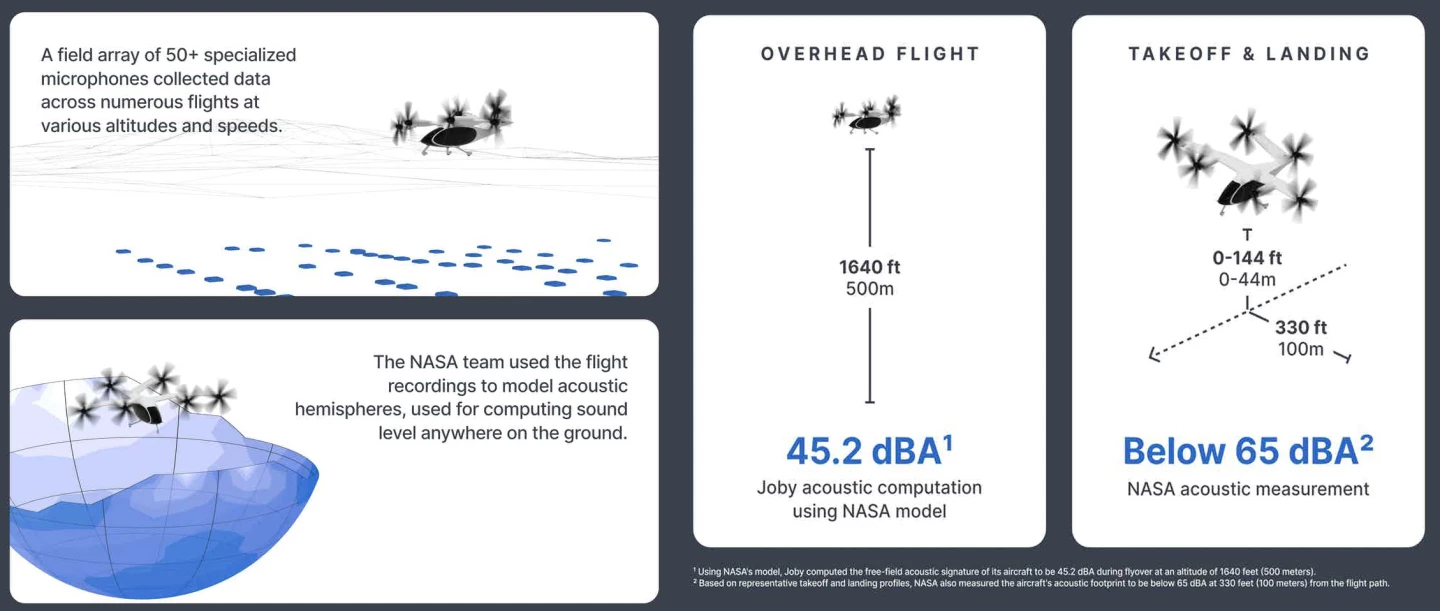One of eVTOL companies' core promises is that these electric air taxis will be vastly quieter than helicopters – so quiet that we'll be able to fill the skies with hundreds of them without subjecting city dwellers to brutal levels of added noise pollution.
Now, Joby Aviation has put some numbers on its acoustic performance. Working with NASA as part of its Advanced Air Mobility National Campaign, Joby flew its S4 prototype over NASA's Mobile Acoustics Facility, a field array of more than 50 microphones, at varying altitudes and speeds, to create a model of its acoustic signature during different phases of flight.
The company has published two useful figures arising from these tests. Firstly, when the S4 flies overhead at an airspeed of 100 knots (~115 mph/185 km/h), and at an altitude of 500 m (1,640 ft), it measures about 45.2 dBA on the ground. That's somewhere between "refrigerator" and "moderate rainfall" on a decibel chart, and the company calls it "a sound level which Joby believes will barely be perceptible against the ambient environment of cities."
Secondly, while the aircraft is taking off and landing, noise levels measured 100 m (330 ft) from the vertipad stayed below 65 dBA over more than 20 VTOL tests, with the aircraft rising to or descending from an altitude of 44 m (144 ft). So somewhere between "normal conversation" and "toilet flush/vacuum cleaner" on the decibel charts.

An attempt to put these eVTOL noise levels into context
In order to imagine what future skies full of eVTOLs might sound like, I downloaded one of the many free dB meter apps for smartphones and watched the meter responding to different sound levels in my house and around my relatively quiet suburban back yard, during a painfully average Wednesday. So what follows is highly subjective and based on a dodgy instrument that would never be used for official noise tests – but I found the exercise worthwhile.
For a room to feel pretty much silent to me, the sound pressure level needs to be around 20 dBA or below. Ambient traffic noise out the back in my little office/studio, with the door open, measures about 25 dB, and this rises into the mid-30s when a car comes down my street. If I stand right next to the relatively busy road out the front, high-frequency tire noise from passing cars doing about 50 km/h (30 mph) is reliably around 60 dBA and you have to raise your voice to be heard over it. That's at its peak; they go by pretty quickly and the noise recedes within a few seconds.
Aircraft are different, they're audible mainly as engine noise for planes and that familiar choppy blade noise for helicopters, and the sound sticks around for longer. A small plane just flew by making about 50 dBA on the meter with its engine drone, and that didn't sound quiet to me. A helicopter came by a few blocks over, and it registered only 60 dBA but subjectively felt very noisy to me with its mid-frequency chopping.

Joby's aircraft, like most of the other eVTOL contenders, appear to be audible mainly as a kind of roaring whoosh that's probably closer to the signature of tire noise as traffic passes, but won't tail off as quickly – although there's also a bit of the lower-frequency purring or snarling sound you get from a small plane's single front propeller. A 65-dBA takeoff at 100-m distance will sound a bit like you're on the sidewalk of a busy street with cars passing at maybe 80 km/h (50 mph). A 45-dBA flight passing overhead will be a bit quieter than a small plane, and how annoying it is will probably depend on exactly which frequencies come through.
It's hard to dig up good comparison figures for today's helicopters – chopper acoustics is complex, subjective scale frequency weightings differ, not everyone measures from the same distances and directions, and there's a ton of other variables to consider, but figures from the Helicopter Association International suggest that an average helicopter makes around 87 dB on the ground at 500 ft (~150m) of altitude, and around 78 dB at 1,000 ft (300 m). That'll tail off further at the 500-m height Joby was testing at, but still, even in terms of pure sound pressure level, it'd seem that the Joby S4 will be significantly less of a pain in the ears.
What to take away from all this? Well, eVTOLs will definitely be noticeable in the sonic spectrum of the suburbs, particularly at night once traffic dies down. They will blend in more with the hubbub of a city, but if you're closer than a few hundred feet to a vertiport, you're definitely going to know about it when one of them takes off or lands. But they'll be a lot better than helicopters, comparable to the street noise of passing cars, and they'll likely create a type of noise that's easier to ignore than the big rotorcraft.
“We’re thrilled to show the world just how quiet our aircraft is by working with NASA to take these measurements,” said JoeBen Bevirt, Founder and CEO of Joby, in a press release. “With an aircraft this quiet, we have the opportunity to completely rethink how we live and travel today, helping to make flight an everyday reality in and around cities. It’s a game-changer.”
You can (kind of) hear Joby's aircraft taking off at the end of the video below – but caveats apply!
Source: Joby Aviation






